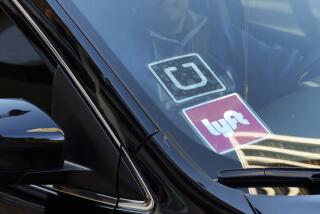Share rides, split costs with strangers on Uber, Lyft and Bandwagon
Ride-sharing companies Uber and Lyft earlier in August rolled out app features that match up people going to the same destinations who want to split the cost of a ride.
Now Bandwagon has joined with taxi-hailing app Hailo to do the same for cabs and licensed car services.
Fare-splitting with friends in the ride-sharing app world isn’t new, but matching up total strangers who pay their share is. Brooklyn-based Bandwagon already allowed travelers to locate others going to the same place, even creating “priority zones” for its users in places with long wait lines for cabs or car services.
But the Bandwagon group could then call Uber, Lyft, a cab, whatever to get to their destination. With the partnership, Bandwagon users e-hail a cab on Hailo, pick up others going their way and pay the split bill on the app.
A company statement says it could reduce the cost of a cab or private car by up to 65%, and it will cut down on your carbon footprint to boot.
“If we can make better use of all those existing empty seats in vehicles that are designed for transportation, we can build a new instant kind of social transit network,” David Mahfounda, Bandwagon chief executive officer and founder, said in the statement.
Lyft Line and UberPool are the new fare-splitting with strangers features that were rolled out this month in San Francisco, where both companies are headquartered, and elsewhere. The rivals say in online announcements that they plan to expand these services too.
And yes, the timing of the rollouts plus other accusations sparked more controversy in the what the Wall Street Journal calls “Tech’s Fiercest Rivalry.” The New York Times also wrote about life in the arch competitive world of “Uber vs. Lyft. vs. regular taxis vs. car ownership.”
In a rare moment of agreement, Uber and Lyft last week supported a California bill that dictates how much insurance and what kind of coverage they should provide, over and above their drivers’ private auto insurance. Gov. Jerry Brown was expected to sign the bill.
But back to Bandwagon and Hailo. Here’s how it works: Bandwagon app users drop a pin on a map at their starting point and another at their destination. They’ll be matched up with ride partners and pay a calculated split fare on their smartphone.
Bandwagon started in 2013 and is funded in part by the Urban Future Lab, a partnership between NYU Polytechnic School of Engineering and the city and state of New York.
More to Read
Sign up for The Wild
We’ll help you find the best places to hike, bike and run, as well as the perfect silent spots for meditation and yoga.
You may occasionally receive promotional content from the Los Angeles Times.







